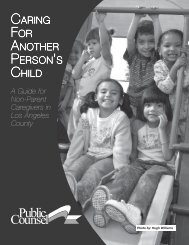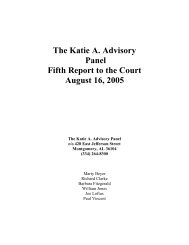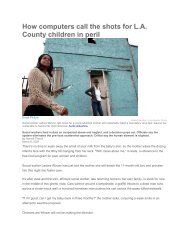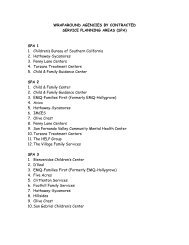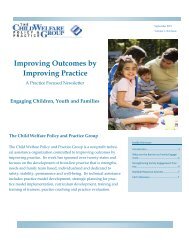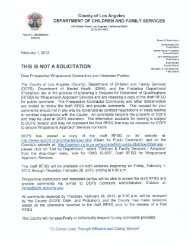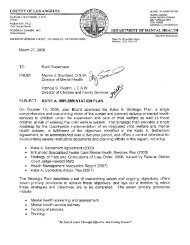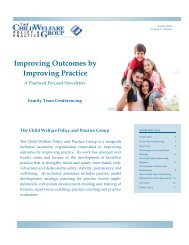DCFS News Winter Issue (PDF) - Los Angeles County Department ...
DCFS News Winter Issue (PDF) - Los Angeles County Department ...
DCFS News Winter Issue (PDF) - Los Angeles County Department ...
Create successful ePaper yourself
Turn your PDF publications into a flip-book with our unique Google optimized e-Paper software.
Five Strategies to Support Three<br />
Key Outcomes<br />
Continued from Page 1<br />
Permanancy Partners Program (P3)<br />
No child should leave foster care without a lifelong<br />
connection to a committed adult. That’s the philosophy<br />
behind P3, a new effort to assist social workers in finding<br />
legally permanent homes and adult connections for the<br />
more than 7,000 youth ages 12 to 18 who are currently in<br />
long-term foster care placements in <strong>Los</strong> <strong>Angeles</strong> <strong>County</strong>.<br />
Piloted a year ago, P3 pairs a specially trained<br />
“permanency specialist” with a youth to identify one or<br />
more adult connections with the goal of reunifying the<br />
youth or moving the youth into adoption or legal<br />
guardianship. At the minimum, P3 hopes to connect each<br />
child with an adult mentor.<br />
Retired social workers have been rehired to help offices<br />
with this effort. In addition, volunteer private investigators<br />
will be used to find adults who youth have identified as<br />
significant, but have lost contact with over the years. More<br />
than 250 youth are now being served by P3 in 16 offices.<br />
“We are beginning a cultural shift,” said Director Dr.<br />
David Sanders. “We need staff to start embracing the<br />
concept that legal permanency for foster children is<br />
achievable and that it is urgent.”<br />
Concurrent Planning (CP)<br />
Concurrent Planning aims to support timely permanence<br />
for children. Safe reunification is <strong>DCFS</strong>’ first priority, but<br />
in the event that this is not possible, Concurrent Planning<br />
ensures that the identification of an alternative placement<br />
plan for children who cannot safely return home is in place<br />
from the beginning.<br />
Working with a labor/management group, the department<br />
implemented changes to Concurrent Planning which<br />
support the safety and permanence for children and<br />
families from the first day they enter out-of-home care.<br />
These system changes include focusing on identifying<br />
relatives and siblings and developing “resource families”<br />
who are committed to working toward reunification and<br />
providing legal permanence if safe reunification is not<br />
successful. Concurrent Planning also engages families and<br />
draws on their strengths and uses ongoing assessments and<br />
case planning.<br />
Structured Decision-Making (SDM)<br />
The goals of SDM are to reduce subsequent harm to<br />
children and expedite permanency. Through proper use of<br />
SDM, staff are able to identify key decision points, increase<br />
the consistency of their decisions, increase the validity of<br />
decisions and better target resources for families. SDM<br />
provides social workers with simple, objective and reliable<br />
tools to make the best possible decisions for individual cases<br />
and provide managers with information for improved<br />
planning and resource allocation.<br />
Components of SDM include several tools: a Response-<br />
Priority which helps determine if and when to safely investigate<br />
Continued on Page 4<br />
Improved Permanence<br />
Improved Safety<br />
Reduced Reliance on Out-of-Home Care<br />
3



